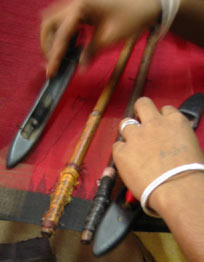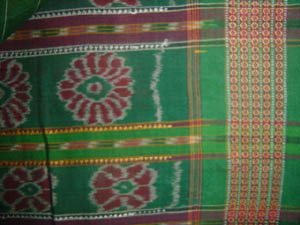by Jaina Mishra
(PART 2)
4.
THE COLOURS
It
must be noted that the color and design palette for men’s dressing is conservative
while women dress in any and every possible colour, design and pattern. The
only exceptions are white, black and red. White signifies death and is
necessarily worn in mourning. Red is auspicious and is necessarily worn
by the bride. Black is unauspicious and is not a good colour to wear at weddings
or festive celebrations. These colors lead to strong associations and
are part of a bundle of nonverbal communication but these may be worn on other occasions without any meaning.
An Odissi saree cannot hope to blend quietly into the background! Most handloom Odissi sarees contains bright and strong colours. I am not sure of the reasons for this choice, but could possibly be dictates of the market. It could also be that these combinations look best on the brown skin. Vegetable dyes have been replaced by chemical dyes, though the former is still available, but the prices are significantly higher.
THE DHOOP-CHAON EFFECT: In silks, a stunning impact is created when the colours of the weft and warp are different. The shadow – light effect is amazing and is not easy to capture on a camera. Movement or difference in field of depth shows this effect off perfectly.


This characteristic is not restricted to sarees from Orissa.
This is the loose end of the saree that flows freely and is usually its most attractive part. The pallaa or paalav or pallo may have contrasting colours or designs and stands out from the rest of the sari. This part may be up to a metre long. It is also the portion used as a partial veil in a temple or as a mark of respect among elders in traditionally conservative societies in the northern belts.




The pallo of the Odissi saree is always arranged in horizontal lines with motifs filling up the space in between. Lines alternating with a variety of motifs seems to be the signature of the classic Odissi textile.
6. THE BORDER
This is a special element
of all sarees. It takes on representations from the culture of the
place that creates it.
The sarees from Orissa have a border which shows the silhouettes of these temples seen as simple mountain peaks. Sea shells or wheels are another major characteristic of borders in Oriya sarees.






The last image is reproduced from Sarisafari.com, with the kind permission of the owner.
7. THE MOTIFS

This one looks quite like the boteh in persian rugs. It takes the form of a raw mango and in this particular case upon a closer look, we can see the peacock which is also a very common decorative element.
Here we see the leaf like tendrils which are also seen again in Isfahans as islimis. These motifs may be found in sarees from all over India and are not restricted to Orissa. This form is also common in other forms of art such as Henna tattoos.


Elements found in nature – flora and fauna are frequently used elements along pallos, borders and in the main body of the saree as buttis. On the sarees pictured here, there are birds, elephants, waves, flowers of many types, leaves, shells and waves.
8. THE BUTTIS
These
are small little elements that may be present all over the saree in some
form of symmetry. They may populate the saree sparsely or densely and
the more work there is on the saree, the ‘heavier’ it gets – not only in
real weight terms but in price perceptions as well. These are minor
elements and cannot on their own create magic. They can only support
the overall design through a splattering of colour or consonant design elements.
These two pictures show details of the ‘buttis’ which are present all over the saree. In sarees from other states, this element plays a major role, but in Oriya sarees, they are generally very sparse and small.


9. THE EMBROIDERY
The
actual embroidery work may be done using ‘zari’ which is golden thread (not
gold – just golden) or silk thread. The presence of golden thread or
zari work makes a sari very heavy figuratively – and the use of such heavy
sarees is warranted only at weddings of families and close friends. Therefore
a zari embroidered sari had limited opportunities to be worn compared to
a silk thread embroidered one. On all the silk examples above, the threadwork is resham or
silk thread.
SUMMARY
A study
of the elements is useful in creating an abstract framework of understanding. Approaching
the subject through a study of similarities and differences in the elements
helps us as outsiders to recreate a complete and internally consistent model
of the development of and the influences on this art. This
is a fulfilling intellectual pursuit. But as in the case of all art,
the piece must be experienced for it to affect us deeply. And so although
the odissi saree lends itself to understanding easily enough, only a touch
and feel experience with a flowing 5 yards can convey its magnificence!

I hope that this photo essay has conveyed the magic and grandeur of Odissi or Oriya Sarees that I have loved and collected for over a decade.
Discussion Return to Part 1